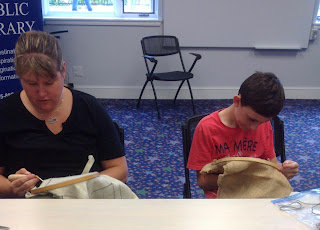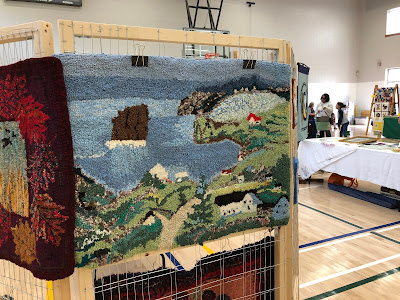 |
| This month's cover of The Economist, featuring "Show Your Stripes" graphic. |
(The information below is intended to supplement a presentation given by Jennifer Wiber, at the Northumberland Rug Hookers Hook-In, Sept 30.)
There’s this thing called data art and it’s being used to highlight important issues. It lends itself very well to rug hooking, as you’ll see.
Data art is defined as a conceptual work of art created using information from a variety of sources, either scientific data, or self tracked data. When we’re presented with a bunch of numbers or information, it doesn’t really sink in. But by working with this data in a creative manner we can achieve greater awareness of complex matters, like climate change.
Data implies the idea of computers, and I’m a big time nerd (I do the web stuff for our branch) so computer-type things don’t bother me, but I’ll show you some examples where computer skills aren’t required.
Much of my talk will be on scientific data, ie weather, used to create art, but for a moment, let’s talk about the self tracked data. There’s been an explosion in this kind of information: think about those folks who track their daily steps, or monitor their sleep cycles. Imagine turning that into some kind of work of art.
Here’s a great article from The Atlantic, on the growing field of data art.
There is an artist named Laurie Frick who has mapped her steps into an amazing 2 storey display. The same person has also made a large installation of her mood (tracked via an app), using laminate countertop samples. She calls it "Moodjam".
 |
| Moodjam by Laurie Frick. From The Atlantic article linked above. |
Bear in mind that you don’t need a computer to do data art - sure, it helps, but there are plenty of folks who have tracked the weather, their eating habits, etc, and then created works of art from it. Some great examples of this are:
- The lady who tracked how late her train was, and knitted a scarf based on this information. It was sold not too long ago for more than $10k with the proceeds donated to charity.

- Then there’s the mayor of NDG in Quebec who sat in council meetings and tracked how often men spoke vs women spoke and turned it into a shawl.

Here's a great video on the topic:
Here's another video of someone showing their completed blanket:
Out of that concept sprang something called The Tempestry Project, where temperature data for a given location is used to create scarves/wall hangings representing several years. These are then hung together in a gallery setting and they tell a very interesting story about climate change. There is a very clear indication that the more recent years are showing a trend towards more extreme temperatures.
 |
| An example of a kit from the Tempestry Project website. |
Folks will often do family groupings - doing a wall hanging for the year of birth of each member of a family, or a family tree, showing the weather in the year of birth for each ancestor.
 |
| A gallery display photo from the Very Pink website |
The Tempestry Project has a website run by an enterprising couple who will:
- Provide you with temperature/precipitation data for whatever location you choose, along with a key/legend showing what colours to use for each temperature range
- Provide you with sufficient yarn to knit a temperature tapestry, in the colours and quantities required.
- In addition to wall hangings people have used this information to do cross stitch pictures, and even knitted a dress, all with this same design.
 |
| An example of a gallery display of several Tempestry wall hangings from the Tempestry Project website. |
I’m a glutton for punishment (and at the time didn’t have a huge stash), so i dyed my own fabric to use for my own tapestry. I worked out that i wasn’t so sure i wanted to do something with 365 rows in a 4 cut - that’s 45 inches - especially if it wasn’t going to work out, so i decided to do something with weekly data.
 |
| Weekly data: Toronto 1957, Montreal 1955 |
 |
| Weekly data coaster, Orono 1934 |
 |
| Daily data, Apsley 1923 |
Ok....so this was starting to show some promise. Then i started doing what i call “birthday mats” - where you collect the temperature on a person’s birthday for every year. Here are a couple of examples. This is the year this person was born, and here’s the current year.... I learned that you have to play around with your temperature scale and the colours, or you’ll end up with a fairly monochrome mat.
 |
| Birthday Mat: May 5, 1955-2019, Toronto |
 |
| Birthday Mat: Jan 8, 1955-2019 |
 |
| Birthday Mat: July 4, 1955-2018 |
 |
| Image from Showyourstripes.org, Annual average temperatures for the GLOBE from 1850-2018 |
He supplies this data, free of charge, for most countries in the world. You simply go to his website, find the stripes for your selected location and you can do what you want with it. here’s an example of the average annual temperature in canada for the last 100 years. The Economist magazine this month featured one of these on its cover (shown at the start of this post).
 |
| Average annual temperature in Canada, 1918-2018, from Showyourstripes.info |
 |
| Simone's rug in the planning stages |
 |
| Simone's rug in progress |
 |
| Simone's colour legend |
Just to prove that I, too, can do something other than straight lines, here's an example of a mat celebrating an anniversary, featuring "balloons".
Hopefully I’ve given you some food for thought for your future projects. In a subsequent post I will provide links to the Tempestry spreadsheets, as well as my own, and give you some hints on other resources to consider for your own project.
Don’t be put off by the fact that computers are often used in data art. I bet, even if you don’t use one, there’s someone in your life with the skills who’d be willing to spend an hour with you on such a project.
Alternatively, you can take a more mindful approach, and record the weather daily by looking out the window or reading your thermometer, and then hook a few rows each week.
Also, be on the lookout for non weather data....I found info on-line about the return of humming birds, the freezing of lakes, monarch butterflies, etc.
The key with these data art projects, especially those addressing the weather, are that they can help to generate a conversation with the audience. Everyone who sees one of these rugs asks what it is, or what inspired it, etc. When I tell them it’s all about climate change, and they see the striped project, they’re amazed at how obvious the change is in the past few years. It creates a greater sense of awareness about what’s going on and hopefully will help us all to realize the impact of our actions. It certainly generates an emotional reaction.
If you do one of these projects, either individually or as part of a group, you, too, can be working to stimulate conversations about climate change. You don’t have to be an expert on the topic - you are just presenting the data, and the facts speak for themselves. Think of how powerful a mat showing the weather for your family would be. Or think of the impact a bunch of mats showing the weather for your community would be if shown all together.
Hope you found this info to be useful!
 |
| A screenshot from Instagram featuring temperature blankets |






























